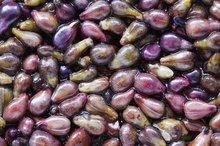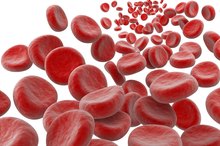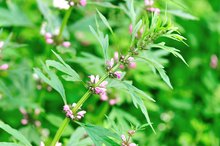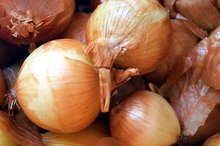Can Herbs Strengthen Capillary Walls?
Capillaries are small blood vessels that transport nutrients throughout our bodies and help carry out waste. The strength of the capillary walls is an important factor in how well the capillaries perform their functions. You can strengthen capillary walls with regular exercise, a low-fat and low-fiber diet and potentially by taking certain herbs. Before using any herbs for these purposes, keep in mind, the FDA does not approve or regulate herbs for medicinal use. If you have concerns about your circulation and the strength of your capillary walls, consult with your doctor at once.
If you are experiencing serious medical symptoms, seek emergency treatment immediately.
Flavonoids
Many herbs contain flavonoids, which strengthen capillary walls and assist the overall circulation of blood throughout the body and brain 1. Flavonoids reduce permeability and promote elasticity of capillaries and blood vessels and attack cell-destroying free radicals in the system. Herbs containing large concentrations of flavonoids include bilberry, calendula, German chamomile, ginkgo biloba and hawthorn.
- Many herbs contain flavonoids, which strengthen capillary walls and assist the overall circulation of blood throughout the body and brain 1.
- Flavonoids reduce permeability and promote elasticity of capillaries and blood vessels and attack cell-destroying free radicals in the system.
Bilberry
Supplements for Abdominal Aortic Aneurysm
Learn More
Bilberry contains a type of antioxidant called anthocyanosides, which may help strengthen capillary walls and blood vessels. They may also increase red blood cell strength, flexibility and production, helping them to carry oxygen more effectively throughout the capillaries. Other purported bilberry benefits include lowering blood pressure and opening blood vessels. Get your doctor's OK before using bilberry.
- Bilberry contains a type of antioxidant called anthocyanosides, which may help strengthen capillary walls and blood vessels.
Ginkgo Biloba
Ginkgo leaf contains more than 26 known active principles that assist the circulatory system on a number of levels, among them facilitating strong and flexible blood vessel walls, including capillaries, veins and arteries. This reduces the risk of blood clots, encourages red and white blood cell profusion, and has a tonic effect on the entire cardiovascular system. Antioxidants in ginkgo may help thin the blood within arterial linings, encouraging elasticity and thwarting plaque forming from arteriosclerosis. Ask your doctor if ginkgo biloba would be suitable for your condition.
- Ginkgo leaf contains more than 26 known active principles that assist the circulatory system on a number of levels, among them facilitating strong and flexible blood vessel walls, including capillaries, veins and arteries.
- Antioxidants in ginkgo may help thin the blood within arterial linings, encouraging elasticity and thwarting plaque forming from arteriosclerosis.
Grape-Seed Extract
How Do the Walls of the Atria & Ventricles Differ?
Learn More
Grape-seed extract contains an antioxidant called proanthocyanidins, or OPCs, which promote blood vessel strength and integrity. OPCs are more effective than are vitamin C and E at building and strengthening cell walls, including those of the capillaries and other blood vessels. They normalize activity in the circulatory system, increasing blood flow throughout the body, and bind to collagen fibers, thereby increasing blood vessel flexibility. They also inhibit two enzymes, collagenase and elastase, which break down connective body tissue. Check with your doctor before using grape-seed extract to ensure your safety.
- Grape-seed extract contains an antioxidant called proanthocyanidins, or OPCs, which promote blood vessel strength and integrity.
Horse Chestnut
Also known as Aesculus hippocastanum, horse chestnut may reduce permeability of capillary walls, helping to prevent radiation absorption and steeling capillaries against damage, among other benefits. It strengthens capillary walls by producing a compound called aescin, which seals "leaks" in capillary walls. It is widely prescribed in Germany for a condition of weakened capillary walls called chronic venous insufficiency, or CVI. Use only prepared horse chestnut extracts and topical ointments, as the herb itself could be toxic. Talk to your physician before using horse chestnut to treat any condition.
- Also known as Aesculus hippocastanum, horse chestnut may reduce permeability of capillary walls, helping to prevent radiation absorption and steeling capillaries against damage, among other benefits.
Related Articles
References
- "Analytical Biochemistry"; Capillary Electrophoresis of Highly Sulfated Flavonoids; Mandakini Dantuluri, et al.; August 2004
- University of Texas at EL Paso Herbal Safety; "Ginkgo Monograph"; Armando González Stuart, Ph.D.; March 2005
- NYU Langone Medical Center; Easy Bruising; 2011
- Ramasamy SK. Structure and functions of blood vessels and vascular niches in bone. Stem Cells Int. 2017;2017:5046953. doi:10.1155/2017/5046953
- Godwin L, Crane JS. Histology, capillary. StatPearls. Updated September 20, 2019.
- Monahan-Earley R, Dvorak AM, Aird WC. Evolutionary origins of the blood vascular system and endothelium. J Thromb Haemost. 2013;11 Suppl 1(Suppl 1):46–66. doi:10.1111/jth.12253
- Maynard RL, Downes N. Histology of the vascular system. Anatomy and Histology of the Laboratory Rat in Toxicology and Biomedical Research. 2019:91-95. doi:10.1016/b978-0-12-811837-5.00008-3
- Wong AD, Ye M, Levy AF, Rothstein JD, Bergles DE, Searson PC. The blood-brain barrier: an engineering perspective. Front Neuroeng. 2013;6:7. doi:10.3389/fneng.2013.00007
- Miller GE. Biomedical transport processes. Introduction to Biomedical Engineering. 2012:937-993. doi:10.1016/b978-0-12-374979-6.00014-9
- Hu D, Cai D, Rangan AV. Blood vessel adaptation with fluctuations in capillary flow distribution. PLoS ONE. 2012;7(9). doi:10.1371/journal.pone.0045444
- Pittman RN. Oxygen transport in the microcirculation and its regulation. Microcirculation. 2013;20(2):117–137. doi:10.1111/micc.12017
- Wright TC, Green E, Phillips JB, Kostyuk O, Brown RA. Characterization of a “blanch-blush” mechano-response in palmar skin. Journal of Investigative Dermatology. 2006;126(1):220-226. doi:10.1038/sj.jid.5700030
- McGrath A, Barrett MJ. Petechiae. [Updated 2019 Jun 8]. In: StatPearls [Internet]. Treasure Island (FL): StatPearls Publishing; 2020 Jan-.
- King D, Morton R, Bevan C. How to use capillary refill time. Archives of Disease in Childhood - Education & Practice Edition. 2013;99(3):111-116. doi:10.1136/archdischild-2013-305198
- Kumar P, Sait SF, Sharma A, Kumar M. Ovarian hyperstimulation syndrome. J Hum Reprod Sci. 2011;4(2):70–75. doi:10.4103/0974-1208.86080
- Krleza JL, Dorotic A, Grzunov A, Maradin M; Croatian Society of Medical Biochemistry and Laboratory Medicine. Capillary blood sampling: national recommendations on behalf of the Croatian Society of Medical Biochemistry and Laboratory Medicine. Biochem Med (Zagreb). 2015;25(3):335–358. doi:10.11613/BM.2015.034
- Freysz M, Cribier B, Lipsker D. Syndrome de Fegeler, angiome plan acquis ou malformation capillaire acquise : trois observations et revue de la littérature. Annales de Dermatologie et de Vénéréologie. 2013;140(5):341-346. doi:10.1016/j.annder.2013.01.436
- Sibley CD, Ramien ML. Capillary malformation–arteriovenous malformation Syndrome. JAMA Dermatology. 2019;155(6):733. doi:10.1001/jamadermatol.2019.0319
- Kapoor P, Greipp PT, Schaefer EW. Idiopathic systemic capillary leak syndrome (Clarkson's disease): the Mayo clinic experience. Mayo Clin Proc. 2010;85(10):905–912. doi:10.4065/mcp.2010.0159
- Ambati J, Fowler BJ. Mechanisms of age-related macular degeneration. Neuron. 2012;75(1):26–39. doi:10.1016/j.neuron.2012.06.018
- Genetics Home Reference. Capillary malformation—arteriovenous malformation syndrome. February 2019.
Writer Bio
Based in Maine, Sage Kalmus has written extensively on fitness, nutrition, alternative health, self-improvement and green living for various websites. He also authored the metaphysical fiction book, "Free Will Flux." Kalmus holds a Bachelor of Science from Boston University's College of Communication and is a Certified Holistic Health Counselor with special training in Touch-For-Health Kinesiology.








